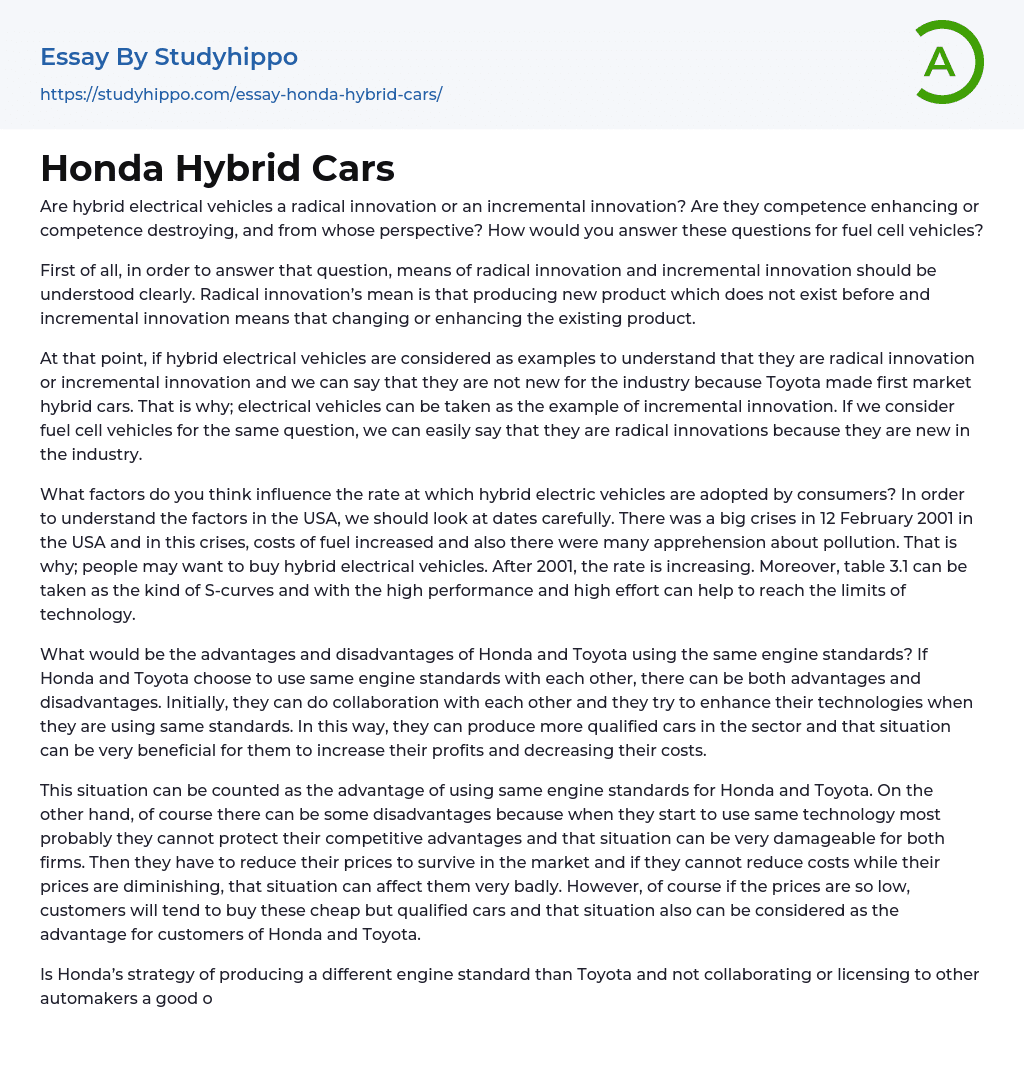Are hybrid electrical vehicles a radical innovation or an incremental innovation? Are they competence enhancing or competence destroying, and from whose perspective? How would you answer these questions for fuel cell vehicles?
First of all, in order to answer that question, means of radical innovation and incremental innovation should be understood clearly. Radical innovation’s mean is that producing new product which does not exist before and incremental innovation means that changing or enhancing the existing product.
At that point, if hybrid electrical vehicles are considered as examples to understand that they are radical innovation or incremental innovation and we can say that they are not new for the industry because Toyota made first market hybrid cars. That is why; electrical vehicles can
...be taken as the example of incremental innovation. If we consider fuel cell vehicles for the same question, we can easily say that they are radical innovations because they are new in the industry.
What factors do you think influence the rate at which hybrid electric vehicles are adopted by consumers? In order to understand the factors in the USA, we should look at dates carefully. There was a big crises in 12 February 2001 in the USA and in this crises, costs of fuel increased and also there were many apprehension about pollution. That is why; people may want to buy hybrid electrical vehicles. After 2001, the rate is increasing. Moreover, table 3.1 can be taken as the kind of S-curves and with the high performance and high effort can help to reach the limits of technology.
What would be the advantages and disadvantages of Honda
and Toyota using the same engine standards? If Honda and Toyota choose to use same engine standards with each other, there can be both advantages and disadvantages. Initially, they can do collaboration with each other and they try to enhance their technologies when they are using same standards. In this way, they can produce more qualified cars in the sector and that situation can be very beneficial for them to increase their profits and decreasing their costs.
This situation can be counted as the advantage of using same engine standards for Honda and Toyota. On the other hand, of course there can be some disadvantages because when they start to use same technology most probably they cannot protect their competitive advantages and that situation can be very damageable for both firms. Then they have to reduce their prices to survive in the market and if they cannot reduce costs while their prices are diminishing, that situation can affect them very badly. However, of course if the prices are so low, customers will tend to buy these cheap but qualified cars and that situation also can be considered as the advantage for customers of Honda and Toyota.
Is Honda’s strategy of producing a different engine standard than Toyota and not collaborating or licensing to other automakers a good one? What would you recommend? When we look at the case study, we can easily say that producing a different engine standards than Toyota and not collaborating or licensing to other automakers provide Honda with many important advantages such as giving Honda more control possibilities its own technological direction and understanding all necessities of technology with
considering its own weak and strong points. I think that Honda should continue to do same thing. In that way, it can increase its competitive advantages in the automobile sector and develop itself more effectively to follow its own way.
Why do you think Honda is simultaneously developing hybrids, diesel, natural gas and fuel cell cars? Should Honda pick one upon which to focus its efforts or is it important for Honda to pursue synergies (and preserve its options) by developing and promoting multiple technologies? Developing hybrids, diesel, natural gas and fuel cell cars show us that Honda improves its technology in different chains and we already know that Honda is getting more powerful day by day in the automobile industry.
I think that Honda should continue to do investment for each chain because in global business world environment and conditions are changing very fast and in order to catch up with these changes, Honda has to be ready and therefore it should produce different types of cars. At that point considering long term and short terms plans can be logical for Honda. It can more focus upon one specific type car which is popular for today as a short term plan. However, if we look at the future, there is a uncertainty about what will happen in the industry. Therefore, Honda should produce different types of cars in different chains as its long term plan.
- Renault essays
- Truck essays
- chrysler essays
- The city essays
- Racing essays
- Bicycle essays
- Cars essays
- Rms Titanic essays
- Adidas essays
- Amazon essays
- Apple essays
- Bmw essays
- British Airways essays
- Burger King essays
- Coca-Cola essays
- Company essays
- Costco essays
- Dell essays
- Ebay essays
- Enron essays
- Facebook essays
- Ford Motor Company essays
- Gap essays
- General Motors essays
- Google essays
- Honda essays
- Ibm essays
- Ikea essays
- Intel essays
- Iphone essays
- Johnson and Johnson essays
- Kellogg essays
- Key essays
- Kfc essays
- Mcdonald's essays
- Microsoft essays
- Myspace essays
- Nestle essays
- Netflix essays
- Nike essays
- Nokia essays
- Pepsi essays
- Pepsico essays
- Red Bull essays
- Ryanair essays
- Samsung essays
- Sony essays
- Southwest Airlines essays
- Starbucks essays
- Supermarket essays




